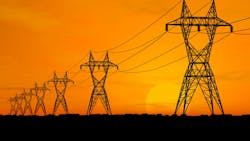I invited Rick Bush, T&D World strategic director, up for a tour of Pittsburgh, Pennsylvania, U.S., which is evolving as a hotbed of innovative solutions to the critical challenges we face in energy reliability, sustainability and security. In addition to Pitt’s Electric Power Systems Lab, Rick also toured the Energy Innovation Center where Pitt and its partners are developing AC and DC grid laboratory capabilities. Nearly 135 years ago, this region was the site of the famous “war of the currents” between Edison, Tesla and Westinghouse. AC won that battle. But now, with the evolution of power electronics technologies and the development of HVDC breakers and other supporting technologies, we are seeing DC evolving to challenge AC as a worldwide standard for electricity delivery infrastructure for the following reasons:
1. Many new long-distance transmission lines in the U.S., Asia and Europe are moving toward ultra-high-voltage DC (HVDC). HVDC can carry five to eight times the amount of power along a given transmission right-of-way compared to high-voltage AC systems. HVDC applied widely can lead to the elimination of wide-scale cascading blackouts, and today’s voltage-sourced converter technology (VSC) allows for DC networking. In the U.S. and Canada, where we are seeing the emergence of HVDC merchant transmission, many projects apply to transport electricity from major wind and solar farms. All of China’s new high-voltage transmission is planned and built as HVDC. Europe is expanding and upgrading much of its transmission infrastructure with HVDC, including interconnection of nations and continents.
2. DC is inherently compatible with solar and wind. Renewable sources generate power intermittently, requiring storage (batteries) in some applications as part of the system to provide reliable supply, and also require a power conversion interface to the grid. Solar PV is inherently a DC energy supply, as are batteries, making DC a more compatible interface. 3. Modern electrical loads and electronic equipment operate on DC power. Most modern electrical and electronic loads require low-voltage DC power to operate. Yet, we continue to supply this end-use equipment via a legacy AC to DC conversion, resulting in a 5% to 20% power loss.
4. Energy storage integration is greatly enhanced. Energy storage is required to improve the capacity utilization of renewable energy supplies. Most energy storage technologies are DC-based (primarily battery technologies), creating opportunities for improved integration efficiencies and reduced operating losses. 5. DC power is significantly more energy efficient than AC power. Today’s DC motors and appliances have higher efficiency and power-to-size characteristics. Likewise, DC-based LED lighting is as much as 75% more efficient than incandescent lighting. At the high-voltage power grid level, greater efficiency in DC converter technology allows improvements in electricity delivery over long distances.
6. DC and hybrid AC/DC microgrids are being developed for resiliency and reliability. Microgrid applications effectively integrate local and distributed power generation with the main power grid to serve defined end-use loads, improve reliability and create opportunities to buy and sell (net metering) power to minimize energy costs to the consumer. Microgrid designs also increase grid resiliency and energy security.
7. DC is superior to AC for underground and submarine applications. When considering underground and submarine power T&D applications, DC solutions are less expensive than AC for both initial costs and long-term operation and maintenance. DC also requires only two poles compared to AC, which requires three phases, resulting in less overall infrastructure.
8. The technology needed to gain the advantages of DC power in data centers, homes and communities is making significant advances. DC power is already in use at the “bottom of the pyramid’ in rural China, India and other developing nations because existing national (AC) power grids do not reach remote areas. Also, the most significant new consumers of electric power today are companies such as Google and Apple, which operate DC-powered computer data centers and server farms.
9. Electric vehicle growth and adaptation. Electric vehicles with DC batteries can be charged using DC in a fraction of the time needed for AC charging. New electric vehicle infrastructure provides a large growth potential for the electrical transportation sector, leading to reduced carbon emissions and other environmental benefits.
10. New technologies support clean, local, distributed generation of DC power. Solar, wind, second-generation clean biomass and innovative, low-cost fuel cell designs that use natural gas are ideal for green, local power generation. DC infrastructure will improve the integration of such resources into the grid, and enhance their overall economic and environmental value proposition.
I am thrilled to join the effort to support a world powered by DC infrastructure. Expect to see new battles fought between DC and AC as we come full-circle in the 21st century right here in Pittsburgh.
About the Author
Gregory F. Reed
Dr. Gregory F. Reed is a professor and director of the Energy GRID Institute at the University of Pittsburgh's Swanson School of Engineering. He is also the director of the Grid Technologies Collaborative for the U.S. Department of Energy, and an inaugural member of the National Academies of Science and Engineering's Energy Ambassador Program. He will chair the 15th Annual University of Pittsburgh Electric Power Industry Conference (EPIC) in October 2020 at the Energy Innovation Center.
